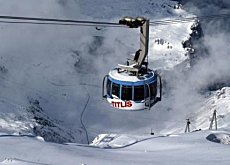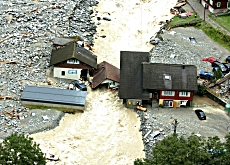Resort learns to manage climate catastrophes

The mountain resort of Engelberg is at great pains not to be the victim of catastrophic flooding again - nor media reports exaggerating the disaster's impact.
No one doubts that the natural beauty of the Alps is the Swiss tourist industry’s main draw card, but nature can turn ugly – as it did in August 2005 when flooding cut Engelberg off from the rest of the world.
Nearly two years later, road crews are still repairing the road above a reinforced embankment washed out along with the railway line by the catastrophe. It was the second time extreme flooding had hit Switzerland in six years.
The damage to this short stretch of asphalt and track at the village entrance severed Engelberg’s only ground transport links for more than two weeks.
Since it was the only Swiss tourist resort to succumb to such a fate, journalists were attracted to the place like bees to honey. Around 200 reporters were flown in by helicopter, and some who weren’t took the long, hard route by foot over mountains to get their story.
The material damage to the community of nearly 4,000 souls whose livelihoods depend either directly or indirectly on tourism was limited to flooded cellars and the ground floors of several buildings including hotels. Most of the repairs were covered by insurance.
The real damage was the SFr18 million ($15 million) in lost revenue after tour operators decided not only to reroute package tourists booked into Engelberg during the 16 days it was inaccessible, but for the rest of the summer and autumn.
“I spent days and weeks just trying to convince tour operators to come back,” tourist director, Fredy Miller, tells swissinfo. The media, according to Miller, gave the impression that Engelberg would never be the same again, even though the cleanup was completed in a few months.
Business as usual
Visitor numbers did return to normal levels the following winter season, and it was business as usual the next summer.
Even though Engelberg generates about 70 per cent of its income during the ski season, the summer has gained in importance.
Engelberg decided a few years ago to become a year-round resort, keeping its hotels, shops and mountain lifts open 11 months of the year. This was a key step in a plan to attract more Asian guests who travel outside the main summer and winter seasons.
The marketing efforts have paid off. According to Miller, Indians spend more nights in Engelberg hotels than in accommodation anywhere else in Switzerland, including cities like Zurich and Geneva.
But as it becomes more of an international resort, Engelberg will have greater difficulty avoiding the media spotlight in times of disaster – no matter how big or small.
If there were to be a next time, Miller would like to exercise greater control over the information that reaches the press.
“The goal would be to give only a little at the beginning and slowly release more after a few days,” he says, “and then switch to positive communication – for example that the road will be open again within two weeks.”
Action plan
Martin Odermatt does not want the situation to reach that point again. “We were able to take action in 2005, but of course it wasn’t sufficient for such an extreme event,” says Odermatt, a member of the village council and head of Engelberg’s emergency task force.
Odermatt has overseen plans to prepare the mountain resort for the worst that Mother Nature can throw at it – from avalanches to landslides and flooding. While the new stretch of road and railway line is being reinforced, more resources have been invested in immediate response efforts and long-term mitigation measures.
Emergency crews will be at the ready to dismantle low bridges in case of flooding and remove dead wood and detritus washed down from the mountains that can clog rivers and streams.
Plans have been approved to raise the embankment to prevent flooding of the village centre while creating flood plains in less built up areas.
Communication remains an important pillar of Engelberg’s strategy. “You have to be careful not to overreact but follow weather events closely,” Odermatt tells swissinfo.
“We have to ensure that guests who have never been exposed to a potentially dangerous situation feel safe. Nature has two sides, and we have to live with that fact.”
swissinfo, Dale Bechtel in Engelberg
Engelberg is located at 1,050m in the central Swiss Alps, 35km from the tourist centre, Lucerne.
Most of its 3,975 inhabitants are either directly or indirectly involved in tourism.
The village grew up around a Benedictine monastery, which still dominates much of life in the village, from schools to cultural events. It also runs its own dairy.
The Swiss authorities say the nationwide flood of 2005 was “without parallel” in modern times. Within 48 hours, more than 100mm of rain fell in places situated on the northern flanks of the Alps. Six people died and damage has been estimated at SFr3 billion.
The environment ministry and other government bodies have concluded that global warming could trigger an increase in such extreme weather events in Switzerland in future.
They say hazard maps should be completed for the entire country by 2011 to pinpoint where measures need to be taken to mitigate the impact of natural disasters.

In compliance with the JTI standards
More: SWI swissinfo.ch certified by the Journalism Trust Initiative












You can find an overview of ongoing debates with our journalists here . Please join us!
If you want to start a conversation about a topic raised in this article or want to report factual errors, email us at english@swissinfo.ch.